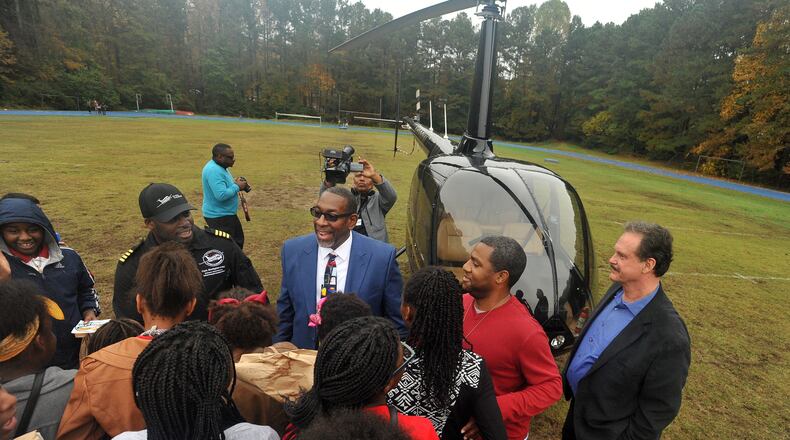Here is an essay from DeKalb Superintendent Steve Green on the expanding role of STEM in his district's schools.
By Dr. Steve Green
There’s an old saying: Give a man a fish, he eats for a day. Teach a man to fish, he eats for a lifetime.
In our DeKalb County School District, we teach kids to fish.
In fact, at McNair Discovery Learning Academy, we’re teaching students to raise fish, right in the classroom. Then they use the fishes’ water to grow vegetables that students donate to hungry families.
Welcome to 21st-century education in DeKalb.
With a strong core of STEM programs like the one at McNair – STEM stands for science, technology, engineering, and mathematics – our students are developing the partnering and problem-solving skills, the technical expertise, and the communication capabilities needed to succeed in a competitive, technology-driven modern world.
STEM education puts together subjects usually taught separately, and then shows students how to apply those subjects to real-world situations. Instead of studying about how fish are raised, for example, students actually raise them … and learn the science, math, and other subjects needed to be successful at the task.
A good STEM program teaches students in an engaging way … but importantly connects the concepts in textbooks to the world in which we live.
DeKalb now has four STEM-certified schools and 94 STEM programs, serving children of nearly every age. Our district leads Georgia in the number (and, we strongly believe, in the quality) of STEM programs. We have 11 more schools ready for certification consideration in 2016.
Thanks to STEM, classrooms in DeKalb feel rigorous, relevant, and related to real life in our 21st century. Industry and university partners are a key component of STEM initiatives. This year alone, our district schools enjoy the support of powerful partners, including The Flying Classroom, Experience Aviation, the Ford Motor Fund, the United States Navy, and HATponics.
These kinds of partnerships, guided by our talented teachers and administrators, bring the world right into the classrooms of DeKalb students … and they spur career and life interests.
At Sagamore Hills Elementary School, students use 3-D printers to create low-flow shower heads. Students at Dunwoody High School are building a coupe car from the tires up. Third graders at Chesnut Charter Elementary School design and 3-D print models of fanciful new animal species.
To master job skills, students at Warren Tech High School, a special education facility, operate an aquaponics greenhouse. (Twice a week, these classes lunch on the fruits of their labor.) Helped by Skype and an interpreter, McNair students collaborate on their classroom fish-and-hydroponic project with peers at a school for the deaf in Jamaica.
These aren’t ivory tower, theoretical, pie-in-the-sky projects. Such hands-on programs open minds … and open doors.
McNair is a Title 1 school where every single student qualifies for free or reduced-cost lunches. There and at many of our district’s 135 schools, educating 102,000 students from 180 nations and with 144 languages, curriculum supported by STEM offers a way out and a way up – a transition path into secondary education, then into full-fledged careers where citizenship requires excellence, engagement, and ethics.
That’s why President Obama and many in the scientific, engineering, and technology communities consider the STEM teaching model a national priority. In light of an increasingly interconnected and tech-driven world economy, education policies … and programs that emphasize science and technology skills development … could mean the difference between future economic progress and stagnation.
“Teachers and principals in schools … are making big strides in preparing students with skills for the new economy,” President Barack Obama said in January 2014. “Some of this change is hard … but it’s worth it … and it’s working.”
In DeKalb, we conceived and launched STEM initiatives to expose students to a rigorous academic environment … but also to let them apply classroom lessons to real-world problems – aquaculture, for example, or vehicle design, or 3-D design/print opportunities. After the discipline of STEM programs, students exit classrooms with improved skills in communication and collaboration, teamwork, and technology use … and with higher overall achievement.
Inside the classroom, where education really happens, DeKalb STEM teachers excel.
Two of our STEM leaders – Jason Raines, a sixth-grade science teacher at Stone Mountain Middle School, and Eric Knapp, an engineering teacher at Tucker Middle School – have been selected for the Northrop Grumman Foundation Teachers Academy. The prestigious academy has accepted just 25 teachers in all the United States … and DeKalb has two.
The STEM model – an integrated instructional process that covers all subjects – continues to surprise us with its flexibility. Our very inventive teachers have created STEM units for the arts, technical writing, informational literacy, and governmental concepts, to mention a few. With our national urgency to make sure our nation doesn’t fall behind in the sciences and math, STEM’s highly integrated content and greater project-based learning makes it the right model for students and our district.
We believe the bedrock of good education is rigor, relevance, and relationships.
Our STEM program gives students all three … and then sends them out from our schools with the 21st-century skills they need to make a difference.
About the Author
Keep Reading
The Latest
Featured



